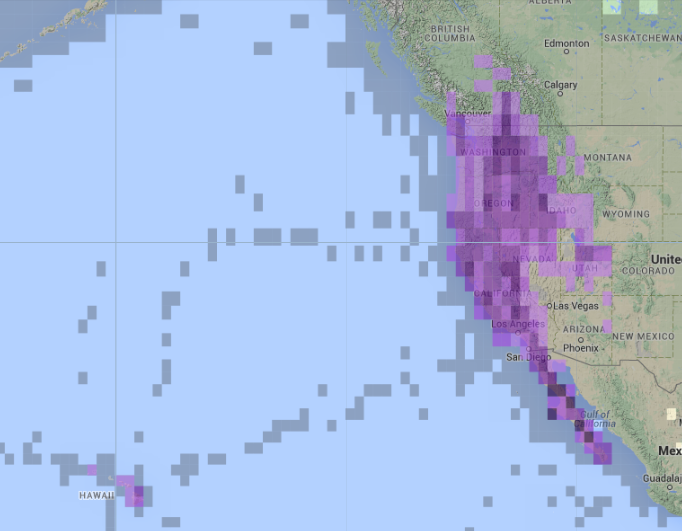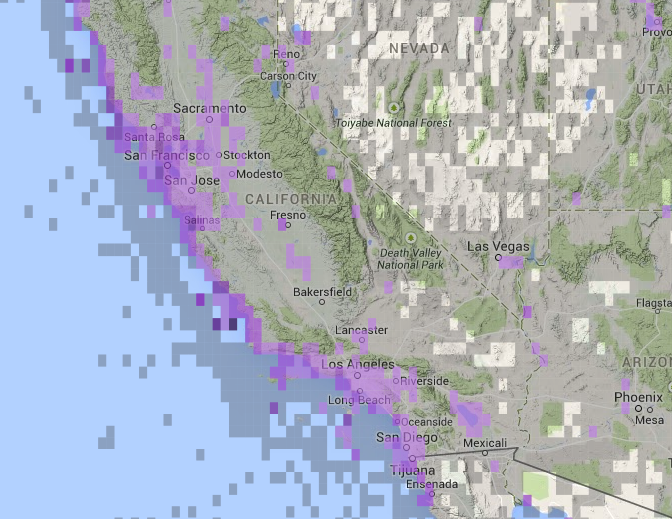Sodden leaves and pulverized acorns robbed the
parking lot of space delineations. I haphazardly swung my Taurus to a halt
across two or three spaces without excessive guilt—the lot was desolate, and I
deemed it unlikely that anyone else would appear on such a blustery October
day. I exited the car and shivered.
I consulted my trunk, that
veritable pantry for outdoor exploration. After a short interval, I located my
jacket, scope, and one glove. Oh well. You really only need one hand to scan.
I had been visiting Manistee Lake
daily, enjoying my role as its only birder. There are so few birders in
northern Michigan that one can possess a harem of lakes to scope. Therefore, I
was highly surprised to see a lean figure, binoculars raised, at the lake’s
margin. Fighting feelings of indignation, I told myself, “Come now. A public
lake is not a concubine. You can share.”
“Hey!” I called as I approached,
“Seeing anything good?” The figure lowered his binoculars and turned.
He was tall, positively gaunt, a
haggard heron of a young man. And his face was concealed by a bandana that had
once been red.
“Your Red-necked Grebe from
Wednesday is still here. Plus a couple Surf Scoters.” He seemed positively
frosty, so I set up my scope at the maximum distance that is socially acceptable
among birders. Obviously, he knew who I was, but to me, he was a man in a mask.
I scanned in silence.
I had been squinting at a bobbing
flotilla of Aythya for five minutes before he spoke again. “We’ve met
before, you know.”
I looked up. He was scanning with
his binoculars—an ancient pair of Zeiss, at least twenty years old. They looked
like looked like they had been through the laundry multiple times. “Yeah?
When?”
“Mouillee, April 2004. Looked at a
couple Yellow-headed Blackbirds together.”
I remembered the birds but not the
birder. “You must have not been wearing the mask,” I observed.
“Nope. That was before I turned
vigilante.”
I chuckled, for now I knew who—or
rather, what—he was. The Masked Birder. A mysterious celebrity in the ABA, a
sort of birder Bigfoot. Rumors swirled. Some speculated that he was the
illegitimate son of one of the birding greats. Some considered him a sort of
Messiah, others disparaged him as a bum, and still others dismissed him as a
narcissistic Quixote. Me? I’m impartial. I mean, birders are a strange bunch. A
birder wearing a mask and bumming around the country isn’t that
unprecedented. Hell—there’s birders who eat cat food, birders who refuse to
ride in internal combustion vehicles, birders who keep meticulous lists of the
birds they’ve seen while urinating…
“So—what brings you to these
parts?” I asked.
“I was at Whitefish for a
week…working on a personal project on sparrow migration, so I’m following the
White-throats south. Saw your eBird reports from this place and decided to stop
in.”
I glanced up and saw him entering
an eBird list on an iPhone. It clashed with his wayfaring persona. “Hey, since
when does the Masked Birder have a smartphone?”
I suspect he would have looked
embarrassed had it not been for the bandana. “It’s, uh, new,” he said. “I was
in Alberta a few months ago and led a rich twitcher to his life Boreal Owl. His
700th. He was so happy that took off his Swaros to give to me. Well,
I’ve got these,” he said, patting his Zeiss. “They were my dad’s, and I’ll
never bird with anything but them. I told him that, and he said, ‘Son, well,
you better take this. You gotta put your stuff on eBird,’ and handed me his
phone.”
“Wow,” I said, scanning through a
cloud of gulls settling to roost. “How do you get around?” I asked, remembering
the dearth of other cars in the lot.
“Walk. Hitchhike. Commandeer
snowmobiles. Grayhound if I have a few bucks. Bald Eagle,” he said, gesturing
overhead. The bird circled, catching the last rays of sunlight.
We watched the eagle in silence for
a couple minutes. Then, I started to collapse my tripod legs. “Listen,” I said,
“There’s a bar just down the road. Wanna go? I’ll buy you a beer.”
“Sure!” he said. He grabbed his
tired-looking backpack and followed me to my car.
By the time we were buckled in, he
had warmed up to me sufficiently that he was babbling nonstop about birds.
First, it was jaeger identification—apparently, during his week at Whitefish,
he had developed a formula for identifying jaegers based on wing beat frequency
(though, variables for wind speed were still giving him trouble). Then, he was
on to thermodynamics and migration. “…you see, bird populations must
conform to the laws of entropy…”
Our arrival at Dingman’s
interrupted his discourse. “Guess I’d better take this off if we’re going in
there,” he said, loosing the bandana and letting it fall around his neck. His
face was youthful and ornamented with wispy facial hair that anyone above the
age of thirteen would not be proud of. His eyes reminded me of a mountain
stream—blue, icy, darting.
As we began to sip our beer, I
asked, “So…why the mask?”
He belched delicately and waved his
hand. “Aw, man. The birding community is just so full of bullshit. Being
anonymous and elusive stirs the pot.”
“Bullshit? Like what?”
“Oh, for one thing, this obsession
with Big Years. Big Days. Big Everythings. Everything in birding has to be
bigger. Kaufman, Komito, Hayward…get real, people. It’s been done before.”
“Well…some people think it’s fun.”
I said.
He drained the last of his pint and
snorted. “Yeah, whatever…then there’s the issue of reputation. You make one
mistake, and you’re screwed for life. Like this kid I used to mentor—one day he
reported a Curlew Sandpiper, turned out to be a Dunlin. Know what? Since then,
he’s become phenomenal, but still, no one believes his reports because of that
one little ID fart five years ago.”
I couldn’t help but agree.
He continued his rant. “And you
become defined by the rarities you find. I’ll bet the ABA has a database
listing all birders by social security number, name, and rarest bird they’ve
found.”
“I don’t believe that.”
The bar tender came over. Asked,
“More beer?”
“Sure!” said the Masked Birder.
“Nah, I’m driving,” I said.
“Okay, well, maybe the database
thing is an exaggeration. But even I know that the rarest bird you’ve ever
found was a Bar-tailed Godwit in 2009. You’d better find something else
fantastic before they forget you.”
I was speechless. Finally, I said,
“Well…you’re right, I guess. Whenever people meet me they say, ‘Oh, you’re
the fellow that found the godwit.’”
The beer arrived, and the Masked
Birder took a draught. “So—what’s the rarest bird you’ve ever found?” I
asked.
He sneered. “I don’t report my
rarities, so that doesn’t happen to me—“
“That makes you an asshole,”
I pronounced.
“Well, wait, wait. I make sure
people find out about them. I’ll be birding around Cape May and find a Garganey
at Lake Lily. I’ll go up to the next capable-looking birder I see and ask him
what he’s been seeing. Then I’ll say, ‘Man, you really should go check out Lake
Lily. There were tons of ducks there, and with the winds we’ve been having,
it’s high time a Eurasian duck showed up.’ Of course, he’ll run over there,
find the Garganey, and get the glory.”
“But what if you’re in the middle of
nowhere?”
“Well…that happens. Either I’ll
leave an anonymous message on the rare bird alert, or I won’t report it. That’s
what happened with my Eurasian Kingfisher in Newfoundland…”
“WHAT?!” I exploded.
“Uh…yeah. Last October. Didn’t
bother reporting it.”
“But that would be the first ABA
record!”
“Yeah.”
“Okay—that makes you an
asshole, I’m sorry,” I said.
To my surprise, he looked hurt. He
drained the last of his beer and signaled for another one. The bartender raised
an eyebrow and fetched another stein. The Masked Birder shifted in his seat and
said, “Yeah, I guess I feel bad about that one. But, in a couple years, I’ll
submit my photos and documentation.”
Our conversation turned to happier
matters—gull identification, Ron Pittaway’s winter finch oracle, the paucity of
young female birders. After his fourth beer, the Masked Birder staggered from
his seat and said, “Well, I’d better get going. Thanks for everything.” He
lurched toward the door like a Reddish Egret.
I jumped up and grabbed his
shoulder. “No way, man, you come with me. You’re drunk, and it’s cold out. Stay
at my house.”
He didn’t resist and followed me to
my car. The whole ride home, he sang Pish & Twitch parodies and
hallucinated Boreal Owls on the roadside. I ushered him into my house, and he
instantly collapsed on my couch, binoculars still looped around his next. I
threw an old blanket over him and went to bed.
Screaming Blue Jays awoke me in the
morning. Snuggling back under my covers, I was nearly asleep again when I
realized that my encounter with the Masked Birder had not been a dream. It all
seemed too bizarre to be true, so I extricated myself from the blankets to
confirm my memory’s veracity. To my surprise, he was gone. He had left a
note—scribbled in child’s handwriting—that read,
Dear Neil—thanks for the
company. I need to continue south. You might want to scope Big Twin Lake this
morning. Yours, The Masked Birder.
I
jammed my bare feet into boots, grabbed my scope, and sprinted down the
driveway towards Big Twin Lake with my laces undone and bathrobe flapping.
Breathlessly I planted my tripod in the damp sand, began scanning, and—there,
fifty yards offshore, was a pristine drake Smew with a raft of Hooded
Mergansers. “You sneak,” I said aloud, reaching for my phone to spread the
news.
It
stayed on the lake for two days, and, as the first state record for Michigan,
it attracted birders the way overripe bananas attract fruit flies. People began
to refer to me as “the guy who found the Smew.” I cringed every time.
A year passed. The guilt mounted—until now, I never
disclosed that it was not I who found the bird. I have not received word of the
Masked Birder since. I often peruse prominent birding blogs in hopes of seeing
mention of him. But—he is ungraspable, like a migrant songbird passing overhead
at night, undetected save for a single note. If you ever encounter the Masked
Birder, treat him to a beer and tell him that I say “hi.”
















































